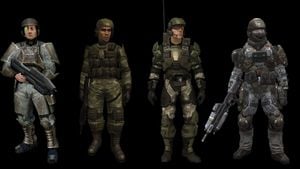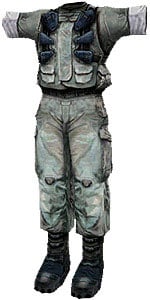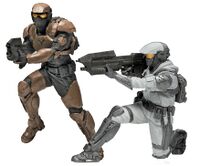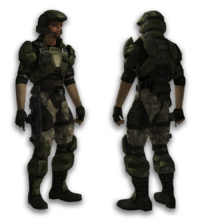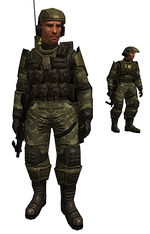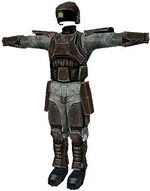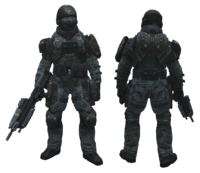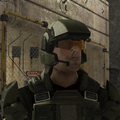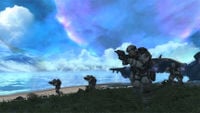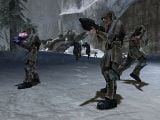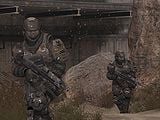UNSC Marine Corps Battle Dress Uniform: Difference between revisions
From Halopedia, the Halo wiki
Shazamikaze (talk | contribs) No edit summary |
m (→Insurrection and early Human-Covenant War: Maintaining the fourth wall) |
||
| Line 34: | Line 34: | ||
{{clear}} | {{clear}} | ||
[[File:M52Bmarinearmor.png|thumb|left|The BDU worn throughout most of the Human-Covenant War.]] | [[File:M52Bmarinearmor.png|thumb|left|The BDU worn throughout most of the Human-Covenant War.]] | ||
[[File:Marine halo 2.png|thumb|right|150px|Another view of the standard BDU | [[File:Marine halo 2.png|thumb|right|150px|Another view of the standard BDU.]] | ||
===2531 to present=== | ===2531 to present=== | ||
This version of the BDU was in limited service as early as [[2531]]<ref>'''Halo Legends''', ''Homecoming''</ref> and had seen more widespread deployment by [[2539]].<ref>'''Halo: Evolutions - Essential Tales of the Halo Universe''', ''The Return'' motion comic</ref> It then saw continued use throughout the war, serving as the standard BDU for Marine forces on [[Earth]]. This model features the [[M52B body armor]], which can be outfitted with various accessories, such as [[Wikipedia:Personal Load Carrying Equipment|utility webbing]] and ammunition pouches; the armor is supported by a black ballistic vest that extends to the arms. The armor and helmet used in conjunction with this model are almost universally painted olive drab, while the fatigues generally feature a woodland camouflage pattern.<ref group="note">The article describes this version of the BDU as it is seen in ''Halo 3'' and later media, as it is a visually updated version of the BDU seen in ''Halo 2''.</ref> | This version of the BDU was in limited service as early as [[2531]]<ref>'''Halo Legends''', ''Homecoming''</ref> and had seen more widespread deployment by [[2539]].<ref>'''Halo: Evolutions - Essential Tales of the Halo Universe''', ''The Return'' motion comic</ref> It then saw continued use throughout the war, serving as the standard BDU for Marine forces on [[Earth]]. This model features the [[M52B body armor]], which can be outfitted with various accessories, such as [[Wikipedia:Personal Load Carrying Equipment|utility webbing]] and ammunition pouches; the armor is supported by a black ballistic vest that extends to the arms. The armor and helmet used in conjunction with this model are almost universally painted olive drab, while the fatigues generally feature a woodland camouflage pattern.<ref group="note">The article describes this version of the BDU as it is seen in ''Halo 3'' and later media, as it is a visually updated version of the BDU seen in ''Halo 2''.</ref> | ||
Revision as of 19:35, September 27, 2011
The UNSC Marine Corps Battle Dress Uniform or BDU is the standard-issue combat uniform worn by the members of the UNSC Marine Corps. Though it provides less protection than more sophisticated armor suits such as the body armor worn by the Orbital Drop Shock Troopers or the MJOLNIR Powered Assault Armor worn by the SPARTAN-IIs, it is very durable and versatile. Ushuaia Armory performed a substantial amount of work on the BDU,[1] suggesting that at least some versions of the BDU were developed by Ushuaia.
Overview
Unlike the Marine Corps Dress Uniform, which is worn at parades and functions, the BDU is intended for use in combat situations. As a large fighting force, the UNSC Marines use a great variety of different BDUs. Standard Marine Battle Dress Uniform consists of armor plating over camouflaged combat utilities, and includes a number of ammunition pockets, holsters, and other features.
Unlike the MJOLNIR Powered Assault Armor worn by the SPARTAN-II supersoldiers, the Marine BDU does not include a dynamic recharging energy shield, providing far inferior protection against directed energy and projectile weapons.
Components
Fatigues
- Main article: Fatigues
Camouflaged combat utilities are worn under the armor plating. The UNSC is known to use a variety of camouflage patterns depending on the environment, including all-grey fatigues, woodland camouflage, urban camouflage, or winter camouflage.
Combat boots
Combat boots such as the VZG7 armored boots are worn with the uniform. They are sometimes equipped with different types of additional armor to provide greater protection to the lower leg.
Armor
The Marine BDU is equipped with ballistic armor at multiple points, including as the torso, the shoulders, and the shins. Some versions incorporate armor in the forearms and thighs as well. The armor is resilient against traditional ballistic weaponry. However, it is easily damaged by plasma weaponry. Different iterations of the BDU feature different armor models, though all possess roughly equivalent durability. Lighter body armor, such as ballistic assault vests, is used in lieu of standard-issue gear during some operations.
Headgear
- Main article: CH252 helmet
All iterations of the BDU feature the CH252 helmet, the standard-issue helmet of the UNSC Defense Force; it is painted to match its corresponding body armor. The helmet may be mounted with various accessories, such as a holographic tactical eyepiece, a helmet recorder, a boom microphone, polarized tactical goggles, a flashlight, or a night vision device. Tactical goggles are also used by some Marines; Marines often wear balaclavas with their helmets, both in frigid and temperate climates. In hazardous situations, gas masks such as the S90 gas mask are worn.
Marines on field operations in more humid locales sometimes choose to wear boonie covers. Marine non-commissioned officers are easily recognized by the cover that they wear, which features the UNSCDF insignia, although they often substitute this soft cover for a more practical protective helmet.
Primary models
Insurrection and early Human-Covenant War
The earliest known iteration of the Marine Corps BDU was in use during the Insurrection[2] and continued to see service well into the Human-Covenant War. The standard version of this model features gray fatigues and brown armor covering most of the body; cold environment versions feature white fatigues, a white helmet, and light gray armor plating. When wearing this model, Marines often sport polarized tactical goggles and balaclavas, even in temperate environments.
The chestpiece used with this model is comprised of very heavy plating. The forearms, shins, and boots are fully armored. Some users wear tactical thigh rigs or holsters, while some wear armor covering the thighs. Often, the left thigh is armored, while a holster is attached to the right thigh.
2531 to present
This version of the BDU was in limited service as early as 2531[3] and had seen more widespread deployment by 2539.[4] It then saw continued use throughout the war, serving as the standard BDU for Marine forces on Earth. This model features the M52B body armor, which can be outfitted with various accessories, such as utility webbing and ammunition pouches; the armor is supported by a black ballistic vest that extends to the arms. The armor and helmet used in conjunction with this model are almost universally painted olive drab, while the fatigues generally feature a woodland camouflage pattern.[note 1]
This version of the BDU lacks the prominent shin armor used with other models, with only the upper shin being armored. This version also lacks thigh armor, though some Marines wear holsters on their thighs. The BDU has black knee and elbow pads, although they are only lightly armored. The uniform also includes armored pauldrons. The V7G7 boots worn with the system are covered in light armor plating. Marines often wear fingerless gloves with this iteration of the BDU.
Reach - summer 2552
The Battle Dress Uniform worn by Marines stationed on the planet Reach in summer 2552 featured gray fatigues, with brown armor plating covering the head, torso, shoulders, thighs, and shins. At times, the Marines only wore their utilities and soft body armor, even forgoing helmets and body armor plating in hazardous combat operations, sometimes substituting their helmets for boonie covers or bandannas. Some Marines had small medical packs built into their back armor plating. Many helmets worn with this system included a holographic tactical eyepiece.[note 2]
This model featured a primary armor unit similar to that of the UNSC Army's BDU, which provided protection to the front and back of the torso, with added protection to the groin. A GUNGNIR pauldron was worn on the left shoulder; the pauldron displayed the UNSC logo and lettering. The right shoulder pauldron was the smaller UA/Base Security shoulder armor, which displayed the Marine's blood type under UNSC lettering. For leg protection, Marines utilized UA/NxRA utility armor, which covered both thighs. They wore heavy armored knee guards distinct from those worn by the Army. Some Marines wore heavier shin armor along with GUNGNIR knee guards. Marines who wore the pressurized Atmospheric/Exoatmospheric (A/X)[5] version of this BDU, such as to mitigate the atmospheric hazards caused by nearby glassing,[6] wore an enclosed ECH252 helmet derived from the Beta-5 Division MP helmet, as well additional collar armor similar to that worn by UNSC Air Force pilots.
Variants
Pilot variant
Marine pilots usually wear a modified version of the standard Marine uniform, though they are known to utilize the BDU without modifications as well. The helmet is generally different from the standard Marine helmet.
Pilots stationed aboard the UNSC Pillar of Autumn wore standard gray fatigues, with a brown leather vest, and helmets with a visor that fully covered the eyes. During the Battle of Mombasa, D77-TC Pelican pilots wore the full Marine Battle Dress Uniform, though they wore wearing pilot helmets with large, golden-polarized visors. Other pilots wear more advanced equipment, including fully sealed helmets and an additional control panel on the standard chest armor piece. Each helmet bears a wing symbol, possibly denoting the pilots' particular specialty, though this may indicated unit affiliation.
Corpsman variant
While many Navy Corpsmen wear the standard BDU, some use a suit with charcoal fatigues and padding with white armor featuring red shoulder straps and caduceus symbols on the shoulder pauldrons for easy identification.[7]
Other suits
While the standard BDU is most commonly seen in the field, there are multiple specialized combat suits worn by different branches of the UNSC Marine Corps. The armor system utilized by the Orbital Drop Shock Troopers is arguably the most notable example of this, being a sealed full-body combat suit instead of a more conventional armored uniform. During operations in vacuum, Marines wear vacuum suits, often equipped with armor plating. One example of a vacuum-enabled suit is the black body suit, which is a lightweight, form-fitting suit of polymer body armor. Other task-specific suits exists, such as the fire-resistant full-body combat suit worn by the Hellbringers. Heavier armored variants of the standard BDU were worn on counterinsurgency operations by 2524, including a suit with charcoal fatigues and matte-black heavy impact plating covering most of the body and a helmet that fully encases the head. This suit may be similar to the ODST BDU.[8]
Trivia
The iteration of the Battle Dress Uniform seen in Halo: Combat Evolved was heavily inspired by the armor worn by the Colonial Marines in the film Aliens, which greatly influenced the game.
Gallery
- All.marines.jpg
Marines wearing the BDU used by personnel assigned to Reach.
- 600px-Halo Wars Marine BR.jpg
Marines in cold environment BDUs.
Ngoc Benti wearing the Corpsman variant of the BDU.
- H3 Zune Marine.jpg
Concept art of the armor for Halo 3.
List of appearances
Notes
- ^ The article describes this version of the BDU as it is seen in Halo 3 and later media, as it is a visually updated version of the BDU seen in Halo 2.
- ^ The article describes this version of the BDU as it is seen in Halo: Reach and Halo: Combat Evolved Anniversary, as it is a visually updated version of the BDU seen in Halo: Combat Evolved.
Sources
- ^ Halo: The Essential Visual Guide
- ^ Halo Legends: Origins
- ^ Halo Legends, Homecoming
- ^ Halo: Evolutions - Essential Tales of the Halo Universe, The Return motion comic
- ^ Halo Waypoint Forums: The UNSC Army discrepancy in CE can be fixed
- ^ Halo: Reach, campaign level The Pillar of Autumn
- ^ Halo: Evolutions - Essential Tales of the Halo Universe, The Mona Lisa motion comic
- ^ Halo: Contact Harvest, page 9
